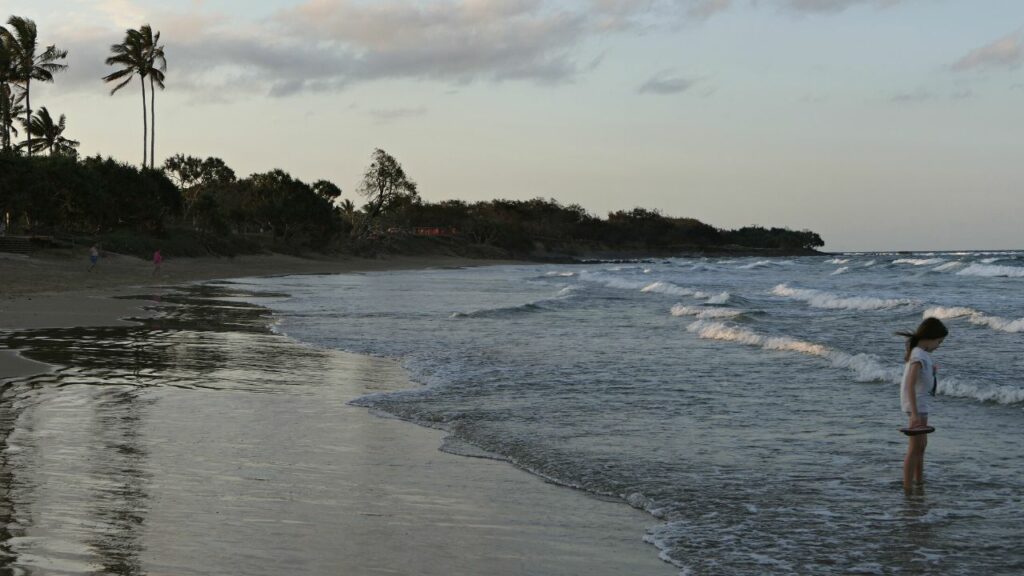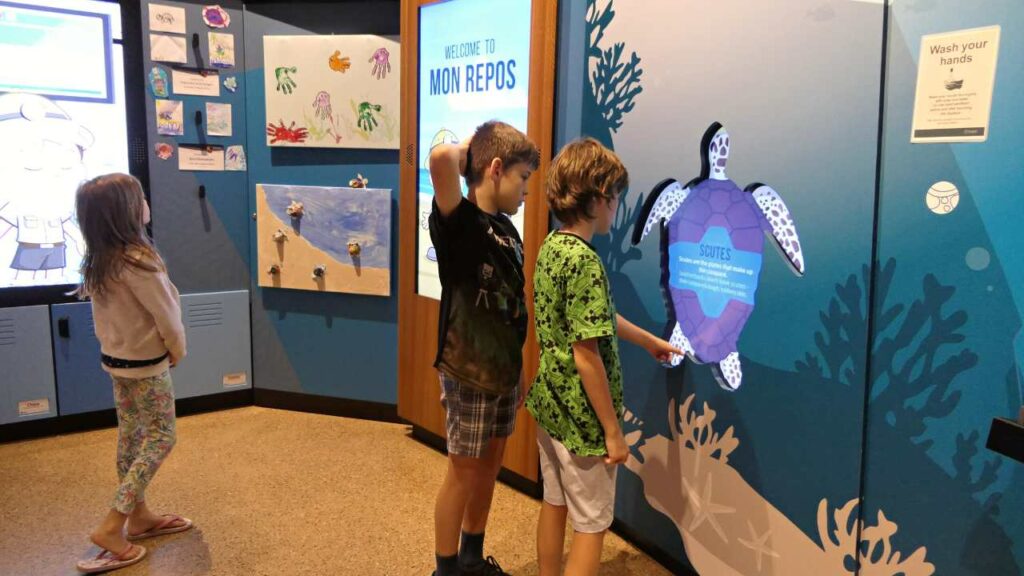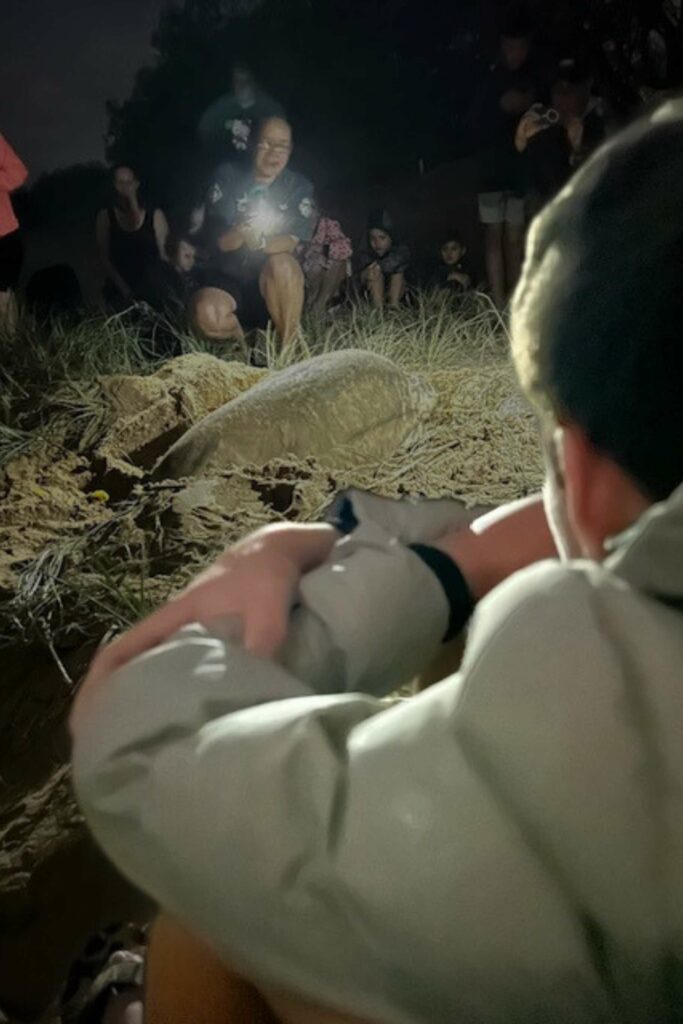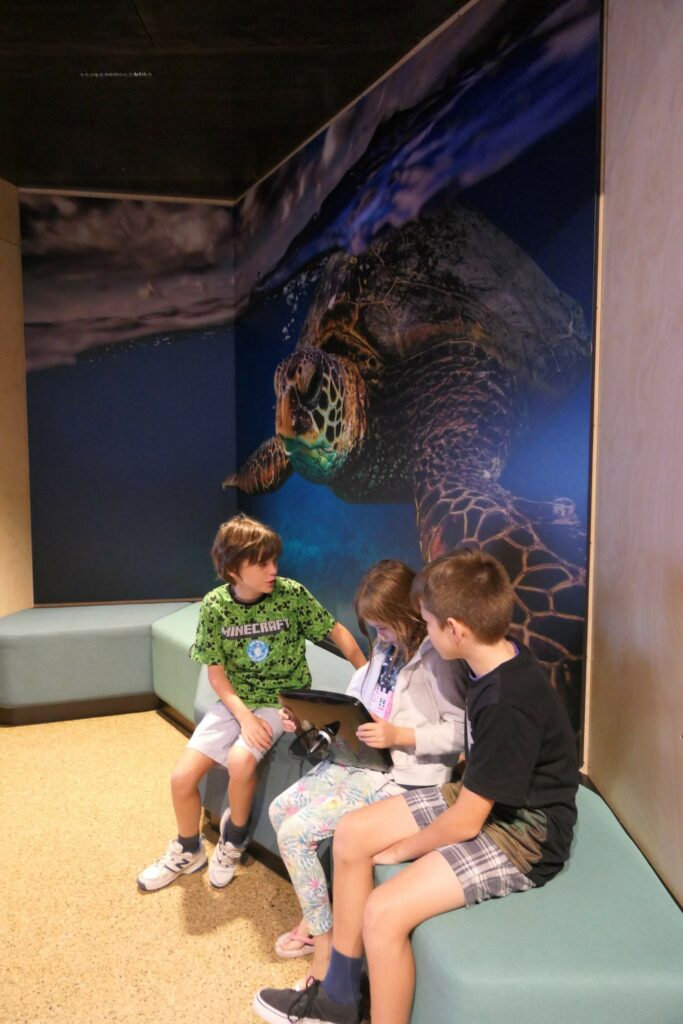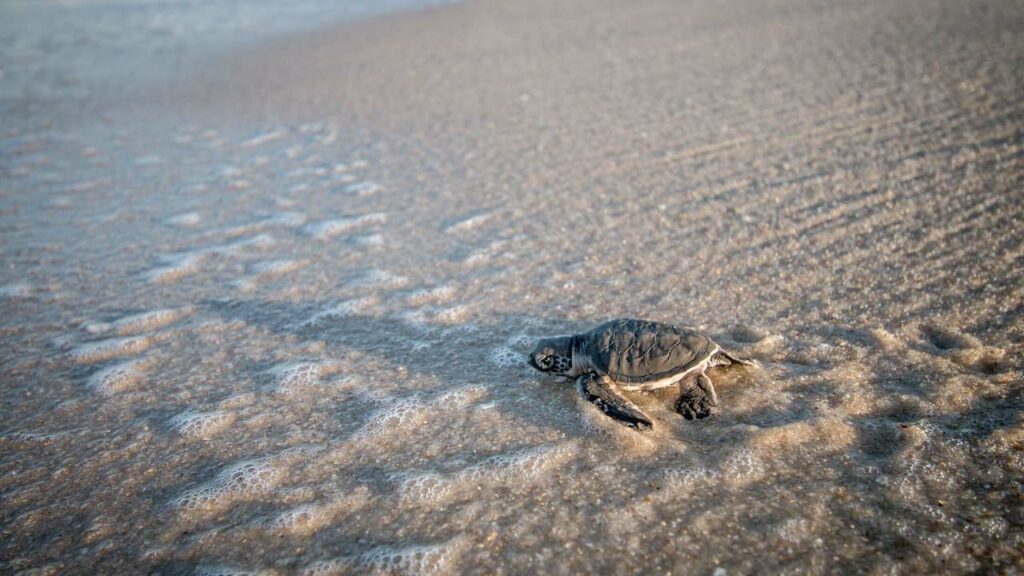Planning a trip in Australia? Don’t forget to shop for travel insurance and car hire in the Move to Australia Directory!
If you get the chance to visit the Mon Repos Turtle Centre to see the turtles at Bundaberg, I highly recommend it! Seeing turtles nesting or seeing the hatchlings is a very unique experience and we’ve always had a wonderful time when we’ve visited. We visited for the second time recently on our East Coast road trip and it was so exciting seeing endangered loggerhead turtles laying clutches of eggs on Mon Repos Beach. This is one of those fantastic travel experiences to add to your must-do list!
Turtle encounters at Bargara near Bundaberg | Seeing turtles at Mon Repos
You can join Park Rangers at the Mon Repos information centre during turtle season to enjoy this unique opportunity. Turtle season runs from November to March, with adult turtles laying their eggs from November to January and turtle hatchlings arriving and scuttling down the beach to the ocean between January and late March.
Top tip: You MUST book your tickets to see the turtles at Bundaberg early – it’s a good idea to sign up to emails from the Bundaberg Visitor Information Centre so you get an alert when they’re going on sale (don’t wait until November as you may find they are sold out!). The earlier you can book your turtle tour, the better.
Your turtle encounter ticket includes access to the Turtle Centre where you can learn all about endangered marine turtles, find out more about Mon Repos Conservation Park and turtle conservation, and visit the gift shop and cafe.
Where is Bargara?
While I talk about seeing turtles at Bundaberg, Mon Repos Beach is actually a 14-minute drive away at the small coastal settlement of Bargara.
As the Mon Repos Turtle Encounter is a nighttime experience, it’s not ideal to do as a day trip to see turtles from Brisbane as it can finish very late, especially if you end up in one of the later guided tour groups to go out on the beach to see the sea turtles coming in.
Ideally, it’s a good idea to organise accommodation close to Mon Repos Beach so you don’t have too far to travel when it finishes (like the Big 4 caravan park). Bundaberg and Bargara both have a Big 4, and they’re convenient and clean places to stay (more details in the ‘Where to Stay to see the turtles at Bundaberg’ section further down the article).
At night, you’ll find a lot of wildlife around so it’s much safer to stay local rather than driving and risking hitting an animal. We’ve seen kangaroos and possums on the road at night after our visits both times.
Overview of seeing the turtles at Mon Repos
Wondering what to expect from your turtle encounter? Read on to find out how the night is structured.
When you arrive at the front desk for your allocated time slot, you’ll be given a sticker to identify your group number. This is the number order in which the groups are called to go out on to the beach. The time on your ticket unfortunately isn’t the time that you will be going out to see the turtles – there will be some waiting around, so be prepared for that. Turtles don’t operate to a time table!
Remember, if you end up booking a later time slot, you will go in a later group i.e. there could be three or four groups going out on a night so people with an early arrival time will be in group one, with the later arrivals being in groups three or four. If you’re in a later group, there is a higher risk of you not getting to see a turtle as it depends on how many turtles are there on a given night as it is impossible to predict. If you can get an earlier time slot, that’s always the best option to give you the best chance of a turtle sighting.
The volunteers process all of the arrivals quickly and you have a chance to browse the gift shop and pick up snacks in the cafe. Later in the evening, the Turtle Education Centre opens so you can spend some time looking around the interactive exhibits.
The wait can be difficult for little ones who are eager to get out and see the turtles. It’s worth taking some colouring or stickers to keep little ones entertained, along with plenty of snacks.
Why visit the Bundaberg turtles as part of a guided tour?
While the beach at Mon Repos is open to the public (so technically you could visit it on your own without booking the tour), it’s important to join a guided Mon Repos Turtle Encounter because turtles are endangered species and they are easily spooked.
A successful breeding season relies on them feeling safe and secure in their habitat – if they are disturbed, they won’t come ashore to lay their eggs. Turtle encounter tour participants are guided by wonderful volunteers and park rangers who also gather important research data and monitor the turtles in their natural habitat. By booking a guided turtle tour, you are supporting turtle conservation.
There are lots of locations in Australia such as Heron Island, Lady Musgrave Island, Exmouth and Lady Elliot Island where you can see turtles coming up to lay their eggs on the beach – it’s a great draw for the tourism industry. However, the success of nesting relies on turtles not being disturbed at the wrong moment so being part of an organised turtle encounter group minimises the environmental impacts you might have.
If you do go along to one of the locations where you can see turtles on a public beach, follow local guidelines about how to best protect them and how to avoid causing harm.
Tickets to see the Bundaberg turtles
Tickets to the Mon Repos Turtle Encounter are priced as follows (prices for the 2024/25 season may change):
- Kids aged 5 – 14 years – $15.10
- Adults and kids aged 15 and over – $29.30
- Family (2 adults, 2 kids) – $70.65
- Concession – $15.10
Getting to Mon Repos Bargara
The Mon Repos Turtle Encounter tours start at the Mon Repos Turtle Centre in Mon Repos Conservation Park, 14km east of Bundaberg in North Burnett. From Mon Repos Road, follow Rookery Road to the car park.
If you have a later time slot, you will likely end up parking further away from the centre, so be prepared for a bit of a walk at the end of the night. It’s worth bringing a torch so you can see where you’re walking on your way out.
What to expect when you visit the Mon Repos turtles
You will be able to enjoy the Turtle Tales immersive experience in the education centre before you go out to see the turtles (and afterwards depending on the time and how much energy you have left).
There is plenty to entertain the kids with interactive exhibits and a little movie theatre that gives you a cinematic tour of turtles’ breeding, facts about turtles and their egg laying and much more.
It’s such a great way to get little ones interested in conservation and wildlife.
Bundaberg turtle hatching
If you want to see the turtles hatching at Bundaberg, you’re going to need to organise your visit between January and March.
Earlier in the season (November to January) you’re able to (hopefully) see female turtles laying her eggs, but if you want to see the cute sight of the baby turtles breaking free from their eggs and making their way on the dangerous journey down the sand to the ocean, you need to come later in the season. I’ve yet to go along to see the tiny hatchlings, but it is definitely something I’m keen to do as it would be an incredible sight.
Things to be aware of when visiting the turtles at Bundaberg…
Here is an overview of the things I’ve learned after visiting the Bundaberg turtles at Mon Repos twice…
- There are no guarantees that you will see the Mon Repos turtles. Wild animals don’t operate to a timetable. Some nights, there are lots of turtles, other nights there might not be many around (and the ones that do show up may arrive very late in the night so you may end up waiting around a lot). I’ve been lucky to see turtles laying their eggs on the two occasions we’ve been, but I know there are occasional nights when people miss out, unfortunately.
- It can get cold at Mon Repos Beach! You’re out on the beach at night. Be prepared for the weather – even if it has been a hot day (and especially if it’s been a hot day, you can really feel the drop in temperature at night all the more). Take jumpers and jackets in a rucksack. Wear jeans or long pants/trousers (this also provides good protection from mosquitoes). A rain mac is handy if the weather looks a bit dodgy as umbrellas aren’t allowed on the beach.
- Think about your footwear. You may have to walk quite a way along dark, sandy tracks to see the turtles, followed by a walk on soft sand. You want to be comfortable. If it’s cold, thongs/sandals will make your feet cold, but then again runners/trainers will easily fill with sand as you walk on the beach to see the turtle nesting. I’ve done both options – the first time we went to see the turtles it was a cool night so I wore runners/trainers, but the most recent time was much warmer so I wore sandals – judge based on the weather! My kids definitely prefer wearing thongs for the walk on the sand though.
- While you might be keen for your budding marine biologists to enjoy this experience, little kids can struggle with this tour – there is a long wait, followed by a long walk, and it’s usually a late night. Plus it can get cold. The first time we did it, our daughter was around 7 years old and she struggled – he legs ached from all the walking, she got very tired and very very cold. While it’s an amazing experience for little ones, be prepared you will likely need to carry them. This time around our kids were 11, 14 and 14 and it was brilliant – they were a great age to enjoy it. I’m not saying don’t take little ones as every child is different, but just be prepared for the juggle. It’s definitely easier going with older kids!
- You need to be moderately fit to do the turtle encounter – the walks can be a fair way (up to 1.6km return) and walking on sand can be tiring. You don’t need to be super fit, but you do need to be mobile.
- You may end up spending around 5 hours or so at Mon Repos. Some of this is waiting to go out on the tour, and then the tour can last a long time. Turtles take time to lay all of their eggs (they lay a LOT of eggs!), and you get plenty of time around the turtle so everyone gets to see. (Again, little kids may struggle with the wait – on our recent tour, lots of toddlers curled up in the sand while waiting for the turtle to finish laying and went to sleep leaving their parents to carry them all the way back!)
- It’s a good idea to bring a torch each. While you can’t shine it around at the beach (as you’d scare the turtles), when you’re on the track at the back of the beach you can shine it on the ground as you walk. As you get onto the beach, your eyes adjust and it becomes easier to see without a torch. The guide will turn on their torch so you get a better view of the turtle when the turtle gets to a stage that the light won’t impact her laying.
- The turtle encounter groups include up to probably 50 people or so. We ended up at the back of the line walking out and it can be very difficult to hear when the rangers are saying but they do rotate people around the turtles when they find one, so everyone gets a turn to see it so don’t worry if you start out at the back of the group (although if you’re close to the front you get to hear more of what the volunteer is saying which adds to the experience so it’s worth trying to walk close to the guide.)
- Bring a water bottle in your backpack. It’s thirsty work being out on the beach all evening.
- You can use a camera without the flash when directed by the volunteer guiding the group.
- Listen to your guide – sudden movements and bright lights can scare off the turtles.
Why are turtles endangered and what can we do about it?
There are lots of reasons why turtles are endangered.
Although marine turtles can lay hundreds of eggs over one nesting season, they don’t begin laying eggs until they are 20 – 30 years old, and they have a break in between breeding seasons.
Although turtles produce a lot of eggs, only 1 in 1000 tiny hatchlings reach maturity so the odds are really against them.
Changes in the ocean temperature because of climate change is impacting the gender of turtles too, meaning more female turtles are being born.
Survival of the endangered loggerhead turtle, green sea turtles and the other marine turtles relies on us taking action by:
- Reducing litter in the oceans and on our beaches
- Keeping nesting beaches dark (as lights stop females from nesting and disorientates hatchings)
- Making sure we knock down any sandcastles and fill in holes in the sand before we leave the beach so they don’t create obstacles for turtles
- Not releasing balloons as they likely end up in the ocean
- Taking care when sailing boats close to the shore
- Not abandoning fishing gear
- Attending organised tours like the one at Mon Repos rather than trying to spot the turtles on the beach on your own.
Where to stay at Bundaberg during turtle tour season
When we visited the turtles at Bundaberg recently, we stayed at the Big 4 Cane Village Holiday Park in Bundaberg. It was a basic caravan park where we stayed in a small one-bedroom unit with a kitchenette and air conditioning. It cost $180 for the night (for 5 of us).
Ideally, for visiting Mon Repos, it’s better to stay at the Big 4 Breeze Bargara (so you don’t have to drive as far in the night and risk the dangers of kangaroos and possums on the road). We’ve stayed at the Big 4 Bargara site in the past but it was booked out for our dates so this was the next best option I could find and it worked well as it was close to Bundaberg’s attractions. Next time, I’ll aim to get in at the Bargara site though for convenience.
- Check out prices for the Big 4 Breeze at Bargara on Booking.com
- Check out prices for the Big 4 Cane Village at Bundaberg on Booking.com
- Check out prices for other accommodation in the Southern Great Barrier Reef region on Booking.com
Tip: Book your accommodation just after you’ve booked your turtle encounter tour. Don’t leave it til the last minute as things do book up.
Bundaberg tour links
I hope you enjoyed this article about going to see the turtles at Bundaberg! I will definitely go back as it’s such an incredible experience. Next time I’m hoping to see the turtle hatchlings!



